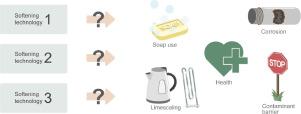Water Research ( IF 12.8 ) Pub Date : 2021-07-15 , DOI: 10.1016/j.watres.2021.117439 Camilla Tang 1 , Martin Rygaard 1 , Per S Rosshaug 2 , John B Kristensen 3 , Hans-Jørgen Albrechtsen 1

|
Drinking water softening is often implemented to increase consumer convenience e.g. by reducing lime scaling and soap use. Softening reduces hardness, but changes also the overall mineral composition of the water, depending on the technology. A broad spectrum of effects from softening has to be considered in relation to e.g. health and corrosion when selecting softening technology and design, otherwise adverse effects may be overlooked in the attempt to increase consumer convenience. We here provided a framework for evaluating softening technologies using water quality indicators for lime scaling, soap use, corrosion, human health, taste and removal of contaminants. None of the evaluated softening technologies scored positive on all the included water quality indicators. Precipitation technologies (lime/soda-ash softening and pellet softening) reduce the predicted copper and lead release, but negatively affect stainless steel corrosion expressed by the Larson Ratio. Pellet softening does not remove magnesium, which may limit the achievable softening depth, but maintains a protective effect against cardio-vascular diseases. Strong-acid cation exchange is not expected to affect the included corrosion indicators, whereas the effects from membrane separation (nanofiltration and reverse osmosis) and weak-acid cation exchange depend on the specific source water and process design. All the evaluated technologies reduce hardness, calcium carbonate precipitation potential (CCPP) and atopic eczema, but have potential adverse effects on dental carries (expressed by DMF-S). Our framework provides a better understanding of softening and can prepare water utility planners and managers for better decisions that balance the positive and adverse effects from drinking water softening.
中文翻译:

饮用水集中软化技术评价与比较:对水质指标的影响
饮用水软化通常用于增加消费者的便利性,例如通过减少石灰结垢和肥皂的使用。软化会降低硬度,但也会改变水的整体矿物质成分,具体取决于技术。在选择软化技术和设计时,必须考虑软化的广泛影响,例如健康和腐蚀,否则在尝试增加消费者便利性时可能会忽略不利影响。我们在此提供了一个框架,用于使用水质指标评估软化技术,包括石灰结垢、肥皂使用、腐蚀、人类健康、味道和污染物的去除。所评估的软化技术在所有包含的水质指标上均未获得正面评价。沉淀技术(石灰/纯碱软化和颗粒软化)减少了预测的铜和铅释放,但会对拉森比表示的不锈钢腐蚀产生负面影响。颗粒软化不会去除镁,这可能会限制可实现的软化深度,但仍能保持对心血管疾病的保护作用。强酸阳离子交换预计不会影响包含的腐蚀指标,而膜分离(纳滤和反渗透)和弱酸阳离子交换的影响取决于特定的源水和工艺设计。所有评估的技术都降低了硬度、碳酸钙沉淀潜能 (CCPP) 和特应性湿疹,但对牙齿携带有潜在的不利影响(以 DMF-S 表示)。


























 京公网安备 11010802027423号
京公网安备 11010802027423号